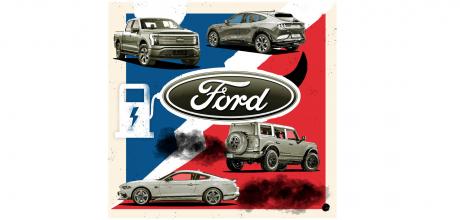Why Ford has split itself in two
Ford’s splitting its EV and combustion-engine divisions, as is Renault. Why? And will it work?
WHY BREAKING IN TWO IS THE NEXT BIG THING
Insider
BEHIND THE HEADLINES
Car makers are embracing the idea of a split personality. Ford is partitioning of its car-making business into Ford Blue and Ford Model E. Blue’s responsibility will be to maintain and further develop combustion-engined cars, and must also be the main revenue driver, while Model E is positioned as the EV and software dynamo.
‘Model E is all about electric vehicles and their development,’ says Ford’s UK MD Lisa Brankin, ‘while Ford Blue is about industrial infrastructure and plants, logistics and so on – all the stuff you need to have a successful business, and that we do really well, that a start-up business doesn’t have.’
The move is designed to help Ford reach its goal of half its global sales volume being EVs by 2030. Ford president and CEO Jim Farley has called it ‘one of the largest automotive transformations in history.’ Ford predicts the new structure will bring a $3bn saving in organisation costs by 2026.
Renault, meanwhile, has announced that it is to make EV and software development the responsibility of a division called Ampere. It aims to employ around 10,000 people in France. ‘If the market values pure players like Rivian, which has more value than Renault, let’s be a pure player,’ says Renault’s Christian Stein. ‘At the same time, we can raise money to finance our own development. EV and software R&D costs a lot, and they’re less profitable than combustion cars.’ Like Ford, Renault sees continuing to make combustion cars as financially essential, at least in the short term. Producing a range that spans full electric, hybrids and efficient combustion engines enables the manufacturer to tailor its line-up to local conditions; some markets are much more ready to go full electric than others.
Renault, says Stein, ‘is more international than it looks, serving markets like Africa, Asia, Korea and Latin America, meaning we’ll still sell combustion cars for a while.’ JATO analyst Felipe Munoz agrees that big manufacturers ‘can’t simply stop producing combustion cars now, not least because they need them to finance their electrification plans.’ Tesla, he argues, is at the root of it all, by changing the game in terms of technology and innovation.
‘Competing against it with the same models is not the way. Traditional car makers need to reinvent themselves – splitting the business is one way to do it.’
But this structural change isn’t attractive to all car makers. ‘The car is one of the most complicated products in the world – I think you need one highly motivated and unified team that works hand in hand,’ Markus Schäfer, chief technology officer of Mercedes, tells CAR. ‘There are no losers and winners here, no old and new technology – everyone is part of the future.’
Organising in a split way could mean a more complicated business structure, and could mean having an entire division staring down the barrel of obsolescence, even if Ford insiders assure us those employees will still have a place in the company. ‘But that’s the risk of having modern guys and an “old fashioned” unit,’ says Stein.
JATO’s Munoz adds: ‘It won’t feel appealing to be in the part that’ll disappear. I also doubt it’ll help businesses react faster to trends. But the combustion-to-EV shift is still at an early stage; splits like this will be temporary.
‘Car makers need to position EVs differently from what they’ve been doing for 100 years – the benefit is consumers will associate them as something more modern.’
BOTH SEE MAKING COMBUSTION CARS AS FINANCIAL SUPPORT, AT LEAST IN THE SHORT TERM
Ford wants to be more like Tesla, but on a much grander industrial scale
Model E vs Ampere: what’s next?
Coming up from Ford and Renault’s EV divisions
FORD
Ford has already teased a whole new line-up of electric cars coming in the next few years in the wake of the announcement the Fiesta, Galaxy and S-Max being culled from its line-up. A new Puma EV is due in 2024, and Ford has announced two new electric crossovers using the VW Group MEB platform, as well as more electric Transit and Tourneo offerings in the Ford Pro division.
RENAULT
Under Luca de Meo, Renault is digging into its history with the 4 (left) and 5 EVs coming from early 2023, joining the Megane E-Tech Electric that’s already on sale. A replacement for the Scenic is to come – teased recently via a hydrogen-electric hybrid concept – but it’ll be much more of a crossover than a proper MPV. Like Ford, Renault is also quietly pursuing fuel-cell cars.


